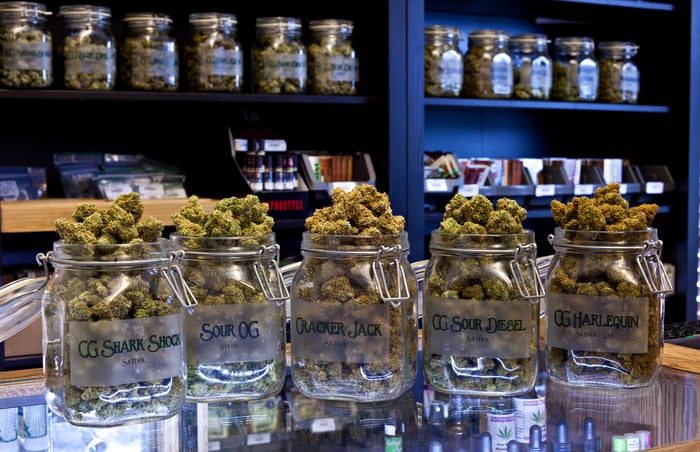 https://cannabisexaminers.com/wp-content/uploads/2020/09/cannabis-marijuana-weed-pot-bud-derivative-cbd-thc-liquid-canada-flag-getty.jpg
https://cannabisexaminers.com/wp-content/uploads/2020/09/cannabis-marijuana-weed-pot-bud-derivative-cbd-thc-liquid-canada-flag-getty.jpg
Few industries offer as much promise this decade as marijuana. After generating $10.9 billion in worldwide sales in 2018, Wall Street analysts are forecasting anywhere from $50 billion to $200 billion in global sales by 2030. While not every pot stock can be a winner, these would appear to be incredible growth figures for investors to piggyback on.
However, there’s been a wild divergence to date between the U.S. and Canadian cannabis markets.

Image source: Getty Images.
Canada completely blew its chance to be a cannabis leader
Despite the U.S. federal government’s failure to legalize weed, quite a few marijuana stocks have flourished. We’ve witnessed two-thirds of all states legalize medical cannabis, with 11 states permitting adult-use consumption and/or retail sale. According to the latest edition of the “Marijuana Business Factbook” from Marijuana Business Daily, the U.S. sold anywhere from $10.6 billion to $13 billion in legal-channel pot last year.
Meanwhile, Canada has been a mess that simply can’t get out of its own way. Even though it’s the first industrialized country to give the green light to recreational marijuana, it’s failed to provide the blueprint for other countries to follow.
Many of its problems can be traced back to regulatory issues. For instance, Health Canada can be blamed for both slowing down the licensing process for cultivators and retailers, as well as delaying the launch of high-margin derivatives. A derivative is a non-dried cannabis product, such as an edible, infused beverage, topical, or vape.
But it wasn’t just Health Canada that made mistakes on the regulatory front. Some provincial regulators also failed badly. Ontario, which is home to almost 40% of Canada’s population, ran with a lottery system for dispensary licenses between Oct. 2018 and Dec. 2019. This lottery system saw just 24 dispensaries open in the first year in a province that could comfortably house 1,000 retail locations.
Without adequate distribution channels, the Canadian cannabis market has experienced everything from supply shortages to suffocating supply bottlenecks, depending on the province.

Image source: Getty Images.
More bad news for Canada’s pot industry
Thankfully, these issues haven’t stopped licensed cannabis store sales from creeping higher over the past two years (sales of adult-use weed began on Oct. 17, 2018). In July, Canadian licensed cannabis store sales hit an all-time high of $231.6 million Canadian ($173 million U.S.), which is up close to 50% from the monthly sales tallied in January 2020.
Things must be getting better for the Canadian pot industry and marijuana stocks, right?
Not exactly.
As we witnessed this past earnings season, one Canadian licensed producer after another reported exceptionally weak cannabis sales growth in the domestic market. It made little sense considering that the coronavirus pandemic, coupled with an increase in new dispensary openings in Ontario, led to a notable uptick in licensed cannabis store sales between March and July. But we may now have an answer as to why these figures were so weak.
Recently, cannabis-focused data and strategic insight company Brightfield Group released a report, “Canadian Cannabis Newbies,” that examined the role new users are playing in the Canadian marketplace. While there were positives mixed throughout, including Canada’s ability to reach medical and recreational users, there was one glaring trend that stood out.

Image source: Getty Images.
Despite the rollout of Cannabis 2.0 — i.e., the aforementioned derivative products that were launched in Dec. 2019, and slowly made their way to retail shelves — new users preferred cannabis flower over derivatives in the second quarter. Whereas derivative use was more or less flat from the sequential first quarter, dried flower use rates among newbies spiked to 43% in Q2 from 28% in Q1.
Why, you ask? For one, dried flower is far more readily available than derivative pot products, which have been constrained by supply challenges. Perhaps more importantly, Brightfield Group opines that so-called newbies have been drawn to dried flower and pre-rolls due to value pricing on these products. Value is especially important with the coronavirus hurting the income potential of workers throughout North America.
The problem is that Canadian licensed producers were counting on Cannabis 2.0 to drive their margins higher. Unfortunately, with the black market remaining resilient in the wake of ongoing supply issues, licensed producers have had to turn to exceptionally low-margin, value-priced, and highly commoditized dried cannabis flower to compete with the black market and draw new users.
In other words, Canada’s cultivators are crushing their own margins in an effort to beat back the black market and secure loyal customers. This is why margins have been so awful of late, and also why revenue figures have been so poor despite licensed cannabis store sales hitting all-time highs.

Image source: Getty Images.
Canadian pot stocks remain off-limits
Given the sea of problems that Canada’s licensed producers have dealt with, as well as the likelihood that they’re now trying to go toe-to-toe with the black market using value-priced dried cannabis, there’s simply no good reason to invest in Canadian marijuana stocks (specifically licensed producers).
Aurora Cannabis (NYSE:ACB) is by far the most popular marijuana stock in North America, but it has also been one of the worst possible investments over the past 18 months. Per its recently released fiscal fourth-quarter results, Aurora’s average net selling price of dried cannabis plummeted 22% to CA$3.60 per gram from the sequential third quarter (Jan. 2020 – March 2020). Even though the company sold 32% more kilograms than it did in Q3 2020, net cannabis revenue actually declined 3%.
It was the same story for the cash-rich Canopy Growth (NYSE:CGC) in the most recent quarter. In spite of a 22% increase in year-over-year net sales, the bulk of this revenue jump came from selling pot products in overseas markets and from its ancillary operations. Canopy’s Canadian recreational revenue actually fell by 11% from the prior-year period to CA$44.2 million. This included double-digit declines in both business-to-business and business-to-consumer sales.
Right now, it doesn’t matter whether we’re talking about the most popular pot stock (Aurora Cannabis) or the largest marijuana stock by market cap (Canopy Growth) — the story is the same. Do yourself a favor and avoid putting your hard-earned money to work in Canadian licensed producers for the time being.

